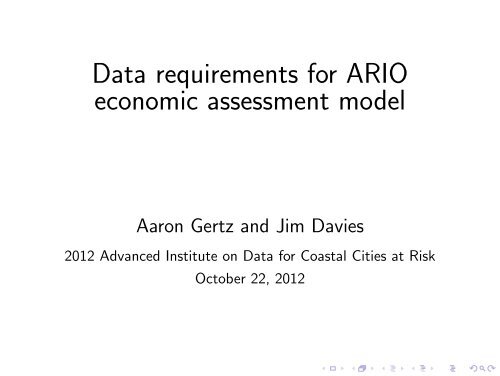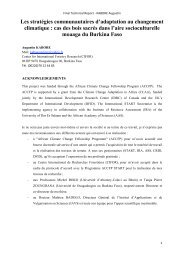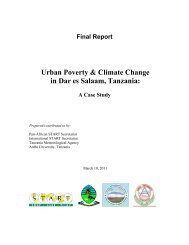Data requirements for ARIO economic assessment model
Data requirements for ARIO economic assessment model
Data requirements for ARIO economic assessment model
You also want an ePaper? Increase the reach of your titles
YUMPU automatically turns print PDFs into web optimized ePapers that Google loves.
<strong>Data</strong> <strong>requirements</strong> <strong>for</strong> <strong>ARIO</strong><br />
<strong>economic</strong> <strong>assessment</strong> <strong>model</strong><br />
Aaron Gertz and Jim Davies<br />
2012 Advanced Institute on <strong>Data</strong> <strong>for</strong> Coastal Cities at Risk<br />
October 22, 2012
Economic impacts of flooding: overview<br />
◮ Direct impacts (damage to capital stock):<br />
◮ Buildings;<br />
◮ Machines;<br />
◮ Infrastructure (transportation, electricity, water);<br />
◮ Indirect impacts:<br />
◮ Intermediate inputs not available;<br />
◮ Labour supply, electricity constrained;<br />
◮ Demand <strong>for</strong> goods reduced.<br />
◮ Other considerations:<br />
◮ Price changes in aftermath of flood;<br />
◮ Recovery process and duration;<br />
◮ Adaptation: Store inventories, increase imports, etc.<br />
◮ Insurance, borrowing, tax base.<br />
◮ Model it! Build on Hallegatte (2008) <strong>ARIO</strong> <strong>model</strong>.
Outline<br />
1. Brief overview of <strong>model</strong><br />
2. Input-output table<br />
3. Damage to capital stock from flooding<br />
4. Recovery<br />
5. Optional: Prices, labour<br />
6. Summary
Model overview<br />
◮ Damage function converts flood level to capital stock<br />
damage by sector.<br />
◮ Each sector’s capacity to produce reduced based on<br />
capital stock damage and capital-output ratio.<br />
◮ Production is allocated between intermediate demand and<br />
final demand (TFD) <strong>for</strong> each industry:<br />
Y (i) = <br />
A(i, j)Y (j)+LFD(i) + E(i) + HD(i) + <br />
D(j, i)<br />
j<br />
<br />
j<br />
<br />
Total Final Demand(TFD(i))<br />
◮ TFD is comprised of local final demand, exports and<br />
disaster damages to households and firms to be repaired.
Model overview - continued<br />
◮ Since production capacity is constrained post-disaster,<br />
there is imbalance between supply and demand.<br />
◮ Iterative procedure used to determine new supply;<br />
intermediate demand satisfied first, TFD demand equals<br />
residual.<br />
◮ Part of residual used to repair capital stock,<br />
HD(i) + <br />
j D(j, i), increasing next period production<br />
capacity.<br />
◮ Price effects enter through adjustment to LFD(i).<br />
◮ Adaptation enters through increased imports and<br />
overproduction.
Input-output table<br />
◮ Different sectors of economy use inputs from each other,<br />
<strong>for</strong> example (Miller & Blair, 2009):<br />
Input<br />
Output<br />
Ag Mfg<br />
Household<br />
Consumption<br />
Other<br />
Consumption<br />
Total<br />
Output<br />
Agriculture 150 500 50 300 1000<br />
Manufacturing 200 100 400 1300 2000<br />
Labour<br />
services<br />
300 500 50 150 1000<br />
Other domestic<br />
payments<br />
325 800 300 250 1675<br />
Imports 25 100 200 150 475<br />
Total 1000 2000 1000 2150 6150<br />
outlays<br />
◮ Use to obtain matrix of technical coefficients, A.<br />
◮ a11 = 0.15.
Input-output table - continued<br />
◮ Input-output tables published by government agencies<br />
often “rectangular” ⇒ Must trans<strong>for</strong>m to square.<br />
◮ Several levels of aggregation (e.g. 3, 15 or 100 sectors).<br />
◮ Damage function <strong>requirements</strong> limits degree of<br />
disaggregation ⇒ use 15-sector level in <strong>model</strong>, perhaps<br />
break out key sectors.<br />
◮ Tables often at national of provincial/state level ⇒ May<br />
need assumptions to create local table.<br />
◮ Example: B.C. I-O table.<br />
◮ I-O tables not published each year, but can typically get<br />
output by sector annually.
Flood damage<br />
◮ To assess <strong>economic</strong> impact of flooding, must determine<br />
damage function D(i, j, l).<br />
◮ That is, damage to capital stock in sector i of type j <strong>for</strong><br />
flood level l.<br />
◮ Ex. Damage to machines in agricultural sector <strong>for</strong> 1 m<br />
of flooding.<br />
◮ Damage function could be obtained in two ways:<br />
1. Using data from past floods;<br />
2. Using standard <strong>for</strong>mulas.
Flood damage - continued<br />
◮ Next must convert capital stock damage to production<br />
constraint ⇒ need capital-output ratios.<br />
◮ If necessary, can use standard capital-output ratios.<br />
◮ Production capacity reduced by<br />
ˆD(i)<br />
, where <strong>for</strong> given l,<br />
κi VA(i)<br />
ˆD(i) = <br />
j D(i, j), κi is the capital-output ratio and<br />
VA(i) is pre-flood “value added”.<br />
◮ Value added is net output, i.e. not counting intermediate<br />
purchases.
Recovery period<br />
◮ In <strong>model</strong>, recovery is endogenous because output used to<br />
reconstruct capital stock.<br />
◮ However, adaptation affects speed of recovery ⇒<br />
adaptation parameters play role in determining pace of<br />
recovery.<br />
◮ Two mechanisms of adaptation:<br />
1. Overproduction;<br />
2. Additional imports.<br />
◮ <strong>Data</strong> on capacity to overproduce in aftermath of flood<br />
(unlikely) or increase in imports (perhaps more likely)<br />
would be helpful.
Prices and labour<br />
◮ Input-output <strong>model</strong>ling neglects price effects on consumer<br />
and firm choices, but in short run little scope <strong>for</strong><br />
substitution.<br />
◮ However, there are some effects of prices even in short<br />
run.<br />
◮ E.g. Surge in demand <strong>for</strong> construction drives up demand<br />
<strong>for</strong> labour in construction which drives up wages.<br />
◮ In GE <strong>model</strong>s, solve <strong>for</strong> price such that supply = demand.<br />
For I-O <strong>model</strong>s, must improvise.
Prices and labour - continued<br />
◮ Model price effects as follows:<br />
◮ Decrease in supply of goods ⇒ price of goods increases<br />
⇒ demand <strong>for</strong> goods decreases.<br />
◮ Income decreases/increases based on demand <strong>for</strong> labour<br />
⇒ decrease/increase in demand <strong>for</strong> goods.<br />
◮ Elasticity parameters determine magnitude of response.<br />
◮ Price data from previous floods could help choose<br />
parameters, but could use standard values.<br />
◮ Labour: Depending on desired output from <strong>economic</strong><br />
module, may need labour (employment) data.
Summary of data <strong>requirements</strong><br />
◮ Essential data:<br />
◮ Input-output table;<br />
◮ <strong>Data</strong>/in<strong>for</strong>mation to localize table;<br />
◮ If table out of date, current output by sector;<br />
◮ Capital stock damage from previous floods or damage<br />
functions.<br />
◮ Desirable data:<br />
◮ Capital-output ratios by sector;<br />
◮ Recovery time <strong>for</strong> previous floods;<br />
◮ Additional imports during floods;<br />
◮ Price/quantity changes during floods;<br />
◮ Labour <strong>for</strong>ce?







